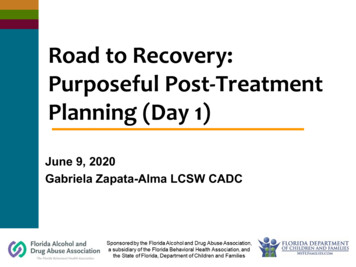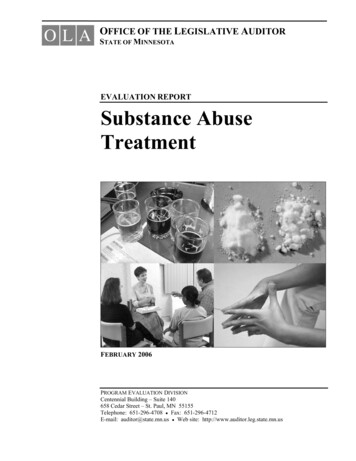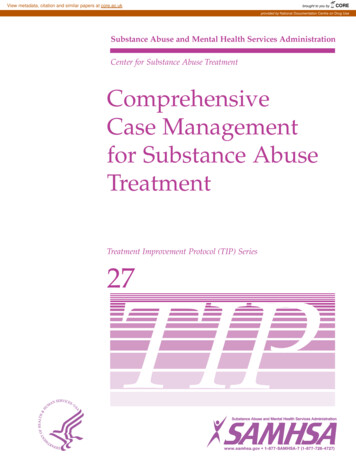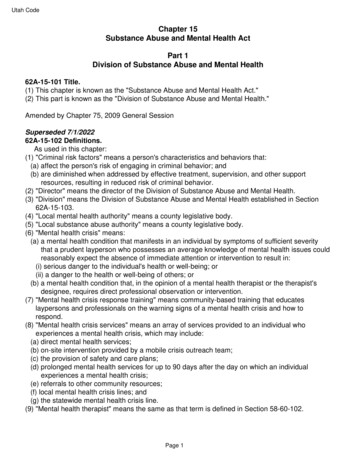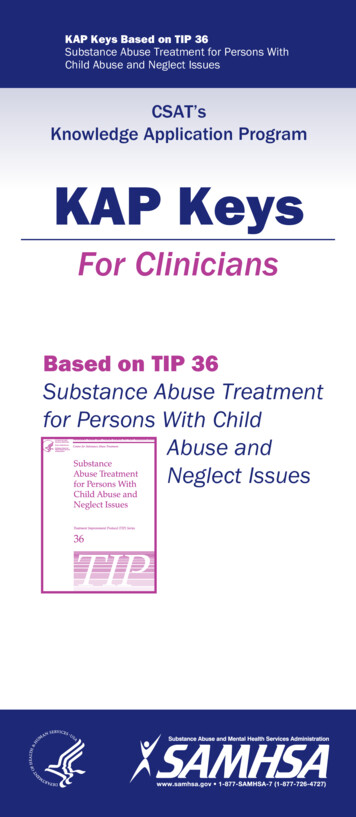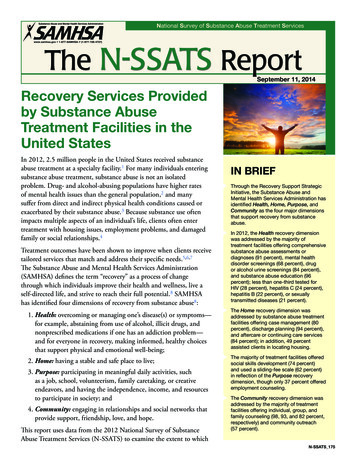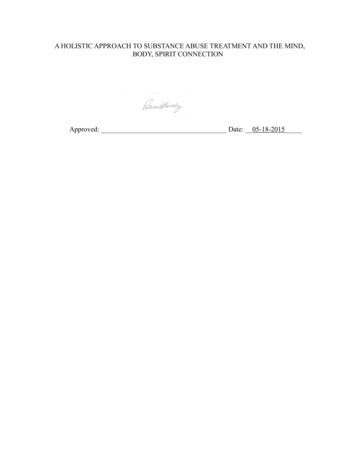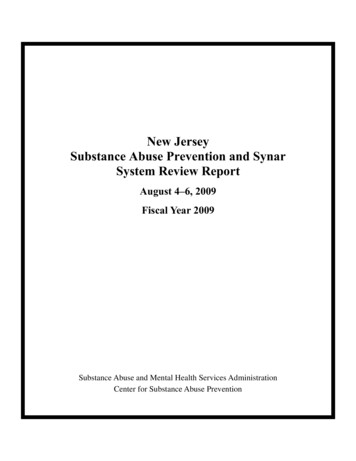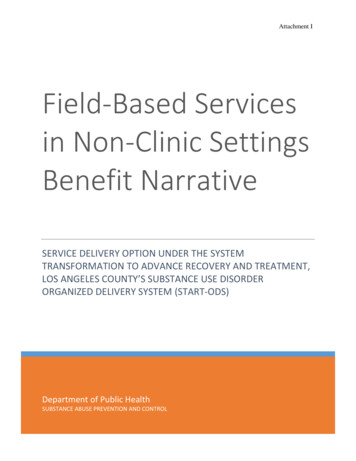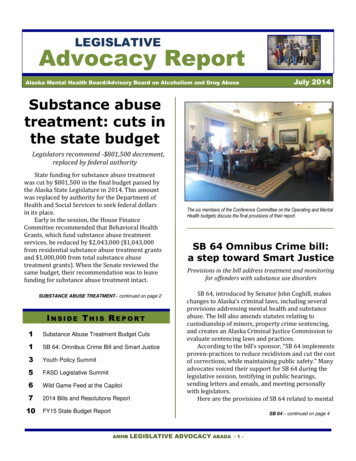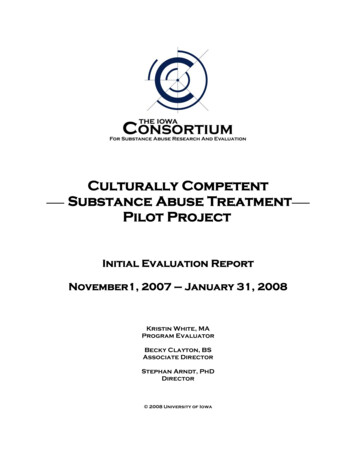
Transcription
Culturally CompetentSubstance Abuse TreatmentPilot ProjectInitial Evaluation ReportNovember1, 2007 – January 31, 2008Kristin White, MAProgram EvaluatorBecky Clayton, BSAssociate DirectorStephan Arndt, PhDDirector 2008 University of Iowa
Citation of references related to this report is appreciated. Suggested citation:White, K., Clayton, R., & Arndt, S. (2008). Culturally Competent treatment pilot program: Evaluationreport. Iowa Department of Public Health (Contract # 5888CP43). Iowa City, IA: Iowa Consortium forSubstance Abuse Research and Evaluation. http://iconsortium.subst-abuse.uiowa.edu/
Culturally Competent Substance Abuse Treatment Pilot ProjectBackground and ObjectivesOn July 1, 2007, The Iowa Department of Public Health received an appropriation from thegeneral fund of the state of Iowa legislature (House File 471) to provide culturally competentsubstance abuse treatment. Through a competitive Request for Proposals process, the IowaDepartment of Public Health awarded three licensed substance abuse treatment providersfunds to implement culturally competent substance abuse treatment pilot projects. The projectswere implemented in November 2007 and continue through June 30, 2008.The objectives of the Culturally Competent Substance Abuse Treatment Pilot Projects are to: increase substance abuse treatment options for racially and ethnically diversepopulations; provide best practices or tried treatment methods and document program outcomesso Iowa treatment providers may adopt culturally competent treatment methods; identify barriers to participants accessing treatment and work with community wraparound services to assist clients with barriers in order to participate in and completetreatment services; maintain contact and support services with clients for (6) months; document and provide program outcomes by working with the Iowa Consortium forSubstance Abuse Research and Evaluation; disseminate information about the pilot project including but not limited to:programming, lessons learned, community involvement, and outcomes as requested;and train substance abuse treatment staff to work more effectively with the targetpopulation.Three agencies were selected to pilot these services: Center for Alcohol and Drug Services(CADS), Employee and Family Resources (EFR), and Jackson Recovery Centers. CADS istargeting 40 Latino and African American clients (with approximately 10 clients being Latino, 30being African American) using the Matrix Model. Employee and Family Resources is targeting75 African American clients using Motivational Enhancement. Jackson Recovery is targeting150 Hispanic clients using the Matrix Model and the Community Reinforcement Approach.Evaluation Process and MethodsConsortium Evaluation ResponsibilitiesThe Iowa Consortium for Substance Abuse Research and Evaluation (Consortium) wasselected to provide evaluation of the Culturally Competent Substance Abuse Treatment PilotProjects. The Consortium’s evaluation responsibilities include the following: develop, administer and collect client surveys on perceived cultural competence of theprograms;develop, administer and collect cultural competency surveys for clinical staff and staffthat are in contact with clients in some direct or indirect capacity, to be given at thebeginning and toward the end of project activities;compile survey results and provide analysis of information collected; and2
compile and report progress information gathered from reports submitted by the threedesignated agencies;provide outcome measure analyses, i.e., length of stay and discharge status for clientsserved in this project.The Consortium also provides training and technical assistance to grantees in administering theevaluation.Agency Evaluation ResponsibilitiesAgency evaluation responsibilities include: disseminate and collect client and staff surveys; mail completed surveys to the Consortium; utilize the I-SMART/SARS reporting system to record client data; provide client admission data to the Consortium; and submit Tri-Annual Progress Reports and a Year End Report to IDPH and theConsortium.Client and Staff Survey InstrumentsClient SurveyThe client survey instrument used in this study is the Iowa Cultural Understanding Assessment– Client Form, adapted from the Assessment Tool for Cultural Competence developed by theMaryland Mental Hygiene Administration of Maryland Health Partners. The MarylandAssessment Tool for Cultural Competence is a 52-item tool designed to assess clientperceptions of the cultural competence of mental health service systems. We wish toacknowledge the work of the Maryland Health Partners on the instrument that formed the basisof the Iowa tool.Consortium staff reviewed published materials regarding The Maryland Assessment Tool forCultural Competence in order to determine the most appropriate questions for this project. Theoriginal developers performed psychometric analyses on the survey items (Arthur et al, 2005;Cornelius et al. 2004). These published reports were used as a basis for selecting questions.The Consortium selected relevant items with a correlation coefficient of 0.5 or greater to createthe instrument for this study. Two items with slightly lower correlations that appeared relevantto this study were also included in the instrument. This resulted in a significant modification tothe original instrument. The number of questions in the instrument was reduced by more thanhalf and the wording of some items was modified to make them appropriate for the substanceabuse field. The resulting Iowa instrument is a 25-item questionnaire designed to assess clientperceptions of the cultural competency of the treatment agency and staff. The instrumentincludes questions regarding client perceptions of staff cultural competency (e.g., “The staffhere understand some of the ideas that I, my family, and others from my cultural, racial, orethnic group may have”), evidence of cultural sensitivity in the physical environment of theagency (e.g., “The waiting room and/or facility has pictures or reading material that show peoplefrom my racial or ethnic group”), and use of culturally appropriate collateral services (e.g., “If Iwant, the staff will help me get services from clergy or spiritual leaders”).The Iowa Cultural Understanding Assessment – Client Form was translated into a Spanishlanguage version by the University of Iowa Cultural and Linguistic Services. This instrument isentitled, “Evaluación del Entendimiento Cultural de la Gente de Iowa – Formulario paraClientes.”3
Staff SurveyThe staff survey instrument used in this study is a modified version of the California BriefMulticultural Competence Scale (CBMCS) developed by Richard Dana, Glenn Gamst, andAghop Der-Karabetian (2004) at the University of LaVerne, California. The CBMCS is a 21-itemself-report questionnaire designed to measure multicultural competence of mental healthservice providers. With the permission of the developers of the instrument, the Consortiummodified the instrument for use with substance abuse treatment providers. This modificationconsisted of changing the words “mental health” to “substance abuse treatment” on nine of thetwenty-one items. This instrument contains questions regarding sensitivity to gender minorities,the aged, and individuals with disabilities, as well as cultural/ethnic minorities. The instrumentincludes items such as: “I am aware of institutional barriers that may inhibit minorities from usingsubstance abuse treatment services” and “I can identify my reactions that are based onstereotypical beliefs about different ethnic groups.”The developers of the CBMCS have created a cultural competency training program forproviders based on the contents of the instrument. The CBMCS Multicultural Training Programprovides up to 32 hours of continuing education credits. The training kit is available throughSAGE Publications (contact information appears in the References section).Survey Procedures and ReportingThe Consortium provides copies of staff and client surveys to participating agencies at thebeginning and near the end of the project. Agencies return the completed surveys to theConsortium for data entry and analysis. Consortium staff double-enter these data and crosscheck for data entry errors. Data on the number of surveys provided to agencies and number ofsurveys returned during this reporting period is provided in the “Survey Results“ section.Demographic information on participants completing these surveys is also provided. TheConsortium will report findings from both surveys in the final project report. Copies of the clientand staff survey instruments appear in the appendix.Client Participation DataThe Consortium created an electronic data management system to manage survey and clientparticipation data for this project. Agencies submit data on client admissions to the Consortiumvia fax on a weekly basis. Additionally, agencies record client data in the I-SMART/SARSreporting system. Consortium staff enters client admission data into the data managementsystem. The Consortium accesses the I-SMART/SARS system to track client participation andobtain data on client length of stay, level of care, and discharge status.Process/Progress ReportingAgencies submit Tri-Annual Progress Reports to IDPH and the Consortium which include thefollowing information: additions to or changes in key personnel;staff training efforts and number of staff trained;organizations to which clients were referred by grantee for additional treatment orancillary services;efforts (other than initial trainings) to expand project’s capacity to serve the targetpopulation;information disseminated to others about project (e.g., newspaper article; T.V. or radiocoverage, public presentations);4
changes in or concerns about grantees financial status that may affect theimplementation or operations of the grant;changes in local conditions that may affect continued project success (i.e. changes intarget population, funding for services);project successes on progress toward goals outlined in the application;project challenges grantee encountered and strategies implemented for overcomingthem;technical assistance needs;number of clients screened;number of clients admitted;number of clients discharged prior to completion; andnumber of clients successfully completing program.The Consortium provides initial and final project reports to IDPH that integrate agency processdata, survey results, and client outcome data.Program ImplementationPersonnelCenter for Alcohol and Drug ServicesKara Harland NCC/LPCProgram Manager, Cultural Diversity Program4230 11th St.Rock Island, IL 61201309-788-4571Additional clinical project staff: one counselor, one case manager (new hire), and one clericalstaff person (new hire). The project is fully staffed.Employee & Family ResourcesHarry Teel, LMHC, CEAPDirector, Substance Abuse Services505 5th Ave, Suite 6000Des Moines, IA 50309(515) 471-2344; (888) 251-4610Additional clinical project staff: one Urban Dreams counselor, one EFR assessmentcounselor/case manager, the EFR Clinical Supervisor. EFR has subcontracted with UrbanDreams who has identified and interviewed qualified substance abuse counselors andanticipates hiring in February, 2008.5
Jackson Recovery CentersAmy Bloch, LISW, CADCProgram Director of Outpatient Services800 5th StreetSioux City, IA 51101712-234-2300Additional clinical project staff: two Spanish speaking counselors (new hires), the ClinicalSupervisor, and the Vice President/Chief Clinical Officer. The project is fully staffed.TrainingSix project staff members received training during this reporting period. CADS trained threestaff persons on record keeping and completing service activity logs. A counselor at UrbanDreams reviewed SAMHSA TIP # 35 on Motivational Enhancement and discussed applicationof the protocol with the Clinical Supervisor. The assessment counselor was previously trainedin Motivational Interviewing but reviewed the TIP #35 manual for this project. The UrbanDreams counselor and the EFR Director were scheduled to attend Community Based Treatmentof Methamphetamine Addiction training in February, 2008. The Urban Dreams counselor andEFR assessment counselor are scheduled to attend Motivational Interviewing (MI) training inMarch, 2008. If Urban Dreams hires an additional counselor prior to that date, the newcounselor will also attend the MI training. Jackson Recovery trained two new project counselorsthrough agency orientation, case management training, and workshops on MotivationalInterviewing and Ethics. Both also receive weekly clinical supervision and participate in anongoing mentoring program with senior therapy staff. The new counselors are scheduled toattend the Spanish Command training in February 2008, Motivational Interviewing Part II in April2008, Stages of Change training in March 2008, Rethinking Substance Abuse & GamblingDisorders training in March 2008, and the Governor’s conference in April 2008.Service Coordination and Community Outreach/EducationTwo of the three participating agencies reported referring clients to other organizations foradditional treatment or ancillary services during this reporting period. EFR referred clients to theMid-Eastern Council on Chemical Abuse (MECCA), Eyerly Ball Community Mental HealthServices, Department of Human Services (DHS), and Family Drug Court. These servicesincluded: higher level of substance abuse treatment after relapse, outpatient mental healththerapy and medication management for co-occurring disorders, and family involvement in drugcourt process as an adjunct to DHS involvement. CADS referred clients to the FamilyResources, Inc. Rape/Sexual Assault Program and to Vera French Community Health Care.Jackson Recovery had not referred clients to ancillary services as the program was justbeginning to admit clients at the time of the report.Each agency reported community outreach and education activities for this reporting period.The case manager at CADS has begun referring clients to spiritual leaders in the communityand is developing a list of these leaders to be used for future referrals. The program counselormet with deacons at St. Mary’s Church to discuss the potential for referrals and the addition ofSpanish speaking spiritual leaders to the referral list. The counselor plans to train the deaconson Alcoholics Anonymous 5th Step work. The program counselor’s business card has beentranslated into Spanish to aid in the referral of Spanish speaking clients. The Cultural DiversityProgram brochure, which will be used to generate referrals and educate community membersabout program services, was created and is pending approval and translation. Cultural Diversityteam members met with representatives from Scott County Kids to provide program information6
and discuss services offered by that agency. The Spanish language interpreters for ScottCounty Kids and the Community Health Center expressed interest in trainings that may beprovided by CADS’ project team.EFR program staff wrote a press release regarding the Culturally Competent Substance AbuseTreatment Pilot Project but this press release was not picked up by the local media. Informationregarding the project and contact information was posted on the agency’s website. EFRinitiated contact with the Polk County Health Department and developed plans to present projectinformation to the Polk County Board of Health Advisory Committee during the next reportingperiod.Jackson Recovery Centers has developed a community outreach/education plan targetingseveral community agencies, employers, and media outlets.Progress and ChallengesCADSDuring this reporting period CADS identified and served thirteen clients in this pilot program,primarily through direct counselor referral. CADS implemented a needs assessment agencywide which aids counselors in identifying clients appropriate for this program and servicesneeded by those clients. In addition, the program counselor has been personally contacted byseveral clients in neighboring communities that are in need of substance abuse treatmentservices in Spanish. A group for primarily Spanish speaking individuals was created inresponse to this need.The counselor is currently reviewing Spanish language treatment materials and translatingagency documents and forms. The agency is using all-staff meetings to distribute programoverview materials, administer staff surveys, and discuss project progress and changes.EFREmployee & Family Resources and Urban Dreams are collaborating to identify and refer clientsto the pilot program. EFR’s assessment counselor spends one day each week at UrbanDreams to assess potential clients and communicate with Urban Dreams’ counselor aboutassessment results. The agency developed a client referral form and program informationsheet for prospective clients. Nineteen clients were identified and served during this reportingperiod. The agency noted that while many of these clients were initially resistant to treatmentdue to perceived pressure from the legal system, most are becoming increasingly open tochange. Staff attributes this change to the non-judgmental approach of program staff.Project staff reported two challenges to program implementation, both of which involve clientretention. Staff lost contact with some clients between the assessment and the time they wereto enter the program. This problem is being addressed though staff asking clients during theassessment interview for multiple contact persons and numbers to increase chances of locatingthe client. The second challenge is clients being unable to remain involved in the program dueto incarceration. The agency has identified a consultant who will assist them in addressing thisbarrier.Jackson Recovery CentersJackson Recovery Centers identified and served three clients during this project period. Thisagency faced a significant barrier to program implementation: that of finding trained substance7
abuse therapists fluent in Spanish. The agency hired two therapists in December who haveminimal substance abuse counseling experience but who are dedicated to serving the Hispaniccommunity. The agency is providing these therapists with extensive training opportunities andongoing mentoring from senior staff. The program began accepting clients late in January.Project staff report concerns that they will not reach the targeted number of clients for thisproject due to the delay in starting the program.Outcome EvaluationThe Center for Alcohol and Drug Services (CADS) is targeting 40 Latino and African Americanclients for this pilot project (with an estimated 10 clients being Latino and 30 being AfricanAmerican). Employee and Family Resources (EFR) is targeting 75 African American clients.Jackson Recovery is targeting 150 Hispanic clients. During the reporting period from November1, 2007 through January 31, 2008, CADS had admitted 13 clients (33% of goal); none weredischarged from the program. ERF had admitted19 clients (25% of goal); three weredischarged prior to completing the program. Jackson Recovery had admitted 3 clients (2% ofgoal); none were discharged from the program. Agencies reported the following number of newclients they plan to serve during the next reporting period (February 1 through April 30): CADS– 7; EFR – 20; Jackson Recovery – 147. However, as noted above, Jackson Recoveryreported concerns about their ability to meet the goal of 150 clients because they were delayedin starting the program due to difficulty hiring Spanish speaking therapists.Table 1. Clients Served in Each Pilot Project as of January 31, 2008.Participating AgencyCADSEFRJackson407515013193Number of ClientsDischarged Incomplete030Number of ClientsDischarged Successful000Goal (total number of clients)Number of Clients AdmittedConsortium staff obtained demographic and treatment level information from the ISMART/SARS system for seventeen clients admitted to the pilot programs. The IowaDepartment of Public Health provides the Consortium with I-SMART/SARS data on a monthlybasis. These data are for clients admitted during the previous month; therefore, there is aminimum one month delay in obtaining client admission data. The low client numbers providedhere reflect the fact that programs were only beginning to admit clients when these data werereported. Of the seventeen clients for which I-SMART/SARS data was available, eight areCaucasian of Mexican ethnicity, two are Caucasian of other Hispanic ethnicity, and seven areAfrican American. All are males. Four of the clients were admitted to medically monitored8
detoxification, three to residential treatment, three to day treatment, and seven to extendedoutpatient treatment.Survey ParticipationThe Consortium sent client and staff surveys to project coordinators at each agency fordistribution near the beginning of the project. Table 2 provides the number and type of eachsurvey provided to the agencies as well as the number of surveys returned during this reportingperiod. This reporting period ran from November 1 to January 31, 2008.Due to the low number of surveys completed during this reporting period, demographic data onrespondents is provided here. Survey results will be included in the final report.Table 2. Number of Surveys Provided and Returned as of January 31, 2008.Participating AgencyCADSEFRJacksonNumber of Client Surveys(English) Provided to Agencies40400Number of Client Surveys(English) Returned to Consortium00NANumber of Client Surveys(Spanish) Provided to Agencies15050Number of Client Surveys(Spanish) Returned to Consortium0NA2Number of Staff Surveys Providedto Agencies402010Number of Staff SurveysReturned to Consortium0010Key:NA Not ApplicableTwo client surveys and ten staff surveys were returned to the Consortium during this reportingperiod. The client surveys were from Spanish speaking clients at Jackson Recovery Centers.Both clients were males of Latino heritage. The staff surveys were also from Jackson RecoveryCenters. Two staff persons were male and eight were female. The age of the staff completingsurveys ranged from 23 to 66 years, with a median age of 44.5 (mean: 41.8). Experience in thefield ranged from 0 to 9 years, with a median of 2 years (mean: 5.7 years). Three staffmembers reported speaking a second language well enough to provide substance abuseservices in that language. Two indicated fluency is Spanish; one indicated fluency in Italian.Five respondents had previous multicultural coursework and one reported currently takingmulticultural coursework. All respondents had attended at least one seminar or workshop onmulticultural issues.9
ImpressionsAll participating agencies are taking action and making progress toward project goals andobjectives. All agencies have admitted clients into the pilot programs and are implementingevidence-based approaches to treating minority clients. Client admission rates were expectedto be low during this reporting period as agencies were focused on start-up activities. Two ofthe three agencies appear on target to reach their goal for number of clients served. JacksonRecovery Centers is below target for this reporting period due to the unexpected delay in hiringprogram staff. It is anticipated that their client admission rates will increase during the nextreporting period. All agencies are increasing their capacity to serve the culturally diversepopulations through training current staff or hiring and training additional staff persons.Agencies are identifying and addressing barriers to treatment for minority clients. Approachesinclude creating Spanish language versions of program materials and asking clients for multiplecontact persons and numbers during the intake assessment to increase agencies’ ability tomaintain contact with clients and engage them in the treatment program. Two of the threeagencies have referred clients to other community agencies for additional services. Agenciesare required under this project contract to maintain contact and support services with clients forsix months. The results of these efforts will be published in the final project report.Community outreach and education activities were conducted by all agencies during thisreporting period. CADS and EFR have begun meeting with other community agencies toprovide information about the pilot program and facilitate referrals between agencies. EFRwrote a press release and added information about the program to their website. JacksonRecovery Centers developed a community outreach plan that will be implemented during thenext reporting period. All agencies are scheduled to participate in a panel discussion at theAnnual Governor’s Conference on Substance Abuse in April to disseminate information aboutthe pilot projects to other treatment agencies. The final project report will include participatingagencies’ impressions of best practices for providing substance abuse treatment to the targetpopulation.All agencies are complying with evaluation and reporting requirements. While survey returnrates appear low, the cutoff date for inclusion in this report was January 31. The Consortiumhas received several additional client and staff surveys since that date. Survey participationrates and survey results will be published in the final project report.10
ReferencesArthur, T. E., Reeves, I., Morgan, O., Cornelius, L. J., Booker, N. C., Brathwaite, J., Tufano, T.,Allen, K. & Donato, I. (2005). Developing a cultural competence assessment tool for people inrecovery from racial, ethnic and cultural backgrounds: the journey, challenges and lessonslearned. Psychiatric Rehabilitation Journal. 28(3), 243-250.Cornelius, L. J., Booker, N. C., Arthur, T. E., Reeves, I., & Morgan, O. (2004). The validity andreliability testing of a consumer-based cultural competency inventory. Research on Social WorkPractice. 14; 201-209.Gamst, G., Dana, R. H., Der-Karabetian, A., Aragon, M., Arellano, L., Morrow, G. & Martenson,L. (2004). Cultural Competency Revised: The California Brief Multicultural Competence Scale.Measurement and Evaluation in Counseling and Development, 37, 3,163-183.For further information on the CBMCS Multicultural Training Program, contact Kassie Graves atSAGE Publications (Kassie.Graves@sagepub.com).11
APPENDIX12
Iowa Cultural Understanding Assessment – Client FormPlease indicate your level of agreement with the statements below by circling thenumber to the right of the statement that best fits your opinion. All responses areconfidential. When you have completed the survey, please either use the pre-addressed,stamped envelope to return the survey by mail or place it in the drop box at the facility.Thank you very much for your participation!Demographic InformationWhat is your sex? MaleFemaleWhat is your race? Alaskan NativeAmerican Indian AsianNative Hawaiian or other Pacific Islander WhiteAre you Hispanic or Latino?YesBlack or African AmericanNoResponseStatement1. The staff here understand some of theideas that I, my family, and others from mycultural, racial, or ethnic group may have.2. Staff here understand the importance ofmy cultural beliefs in my treatment process.3. The staff here listen to me and my familywhen we talk to them.4. If I want, the staff will help me getservices from clergy or spiritual leaders.5. The services I get here really help mework toward things like getting a job, takingcare of my family, going to school, and beingactive with my friends, family, andcommunity.6. The staff here seem to understand theexperiences and problems I have in my pastlife.7. The waiting room and/or facility haspictures or reading material that show peoplefrom my racial or ethnic group.8. The staff here know how to use theirknowledge of my culture to help me addressmy current day-to- day needs.9. The staff here understand that I mightwant to talk to a person from my own racialor ethnic group about getting the help I want.10. The staff here respect my religious orspiritual beliefs.StronglyDisagreeDisagreeNeitherAgree 2345123451234512345123451234513
ResponseStatement11. Staff from this program come to mycommunity to let people like me and othersknow about the services they offer and howto get them.12. The staff here ask me, my family orothers close to me to fill out forms that tellthem what we think of the place and services.13. Staff here understand that people of myracial or ethnic group are not all alike.14. It was easy to get information I neededabout housing, food, clothing, child care, andother social services from this place.15. The staff here talk to me about thetreatment they will give me to help me.16. The staff here treat me with respect.17. The staff seem to understand that I mightfeel more comfortable working with someonewho is the same sex as me.18. Most of the time, I feel I can trust thestaff here who work with me.19. The waiting room has brochures orhandouts that I can easily understand that tellme about services I can get here.20. If I want, my family or friends areincluded in discussions about the help I need.21. The services I get here deal with theproblems that affect my day-to-day life suchas family, work, money, relationships, etc.22. Some of the staff here understand thedifference between their culture and mine.23. Some of the counselors are from myracial or ethnic group.24. Staff are willing to be flexible andprovide alternative approaches or services tomeet my cultural/ethnic treatment needs.25. If I need it, there are translators orinterpreters easily available to assist meand/or my family.StronglyDisagreeDisagreeNeitherAgree 2345* Adapted from the Assessment Tool for Cultural Competence, Maryland Mental HygieneAdministration of Maryland Health Partners.1/200814
Ev
Department of Public Health awarded three licensed substance abuse treatment providers funds to implement culturally competent substance abuse treatment pilot projects. The projects were implemented in November 2007 and continue through June 30, 2008. The objectives of the Culturally Competent Substance Abuse Treatment Pilot Projects are to:

